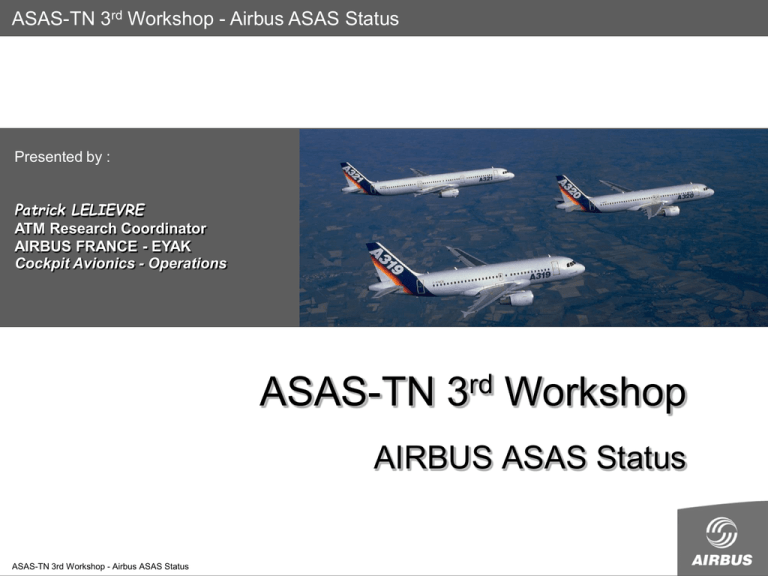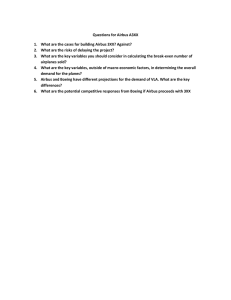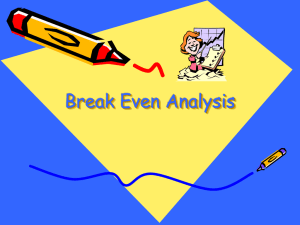
ASAS-TN 3rd Workshop - Airbus ASAS Status
Presented by :
Patrick LELIEVRE
ATM Research Coordinator
AIRBUS FRANCE - EYAK
Cockpit Avionics - Operations
ASAS-TN 3rd Workshop
AIRBUS ASAS Status
ASAS-TN 3rd Workshop - Airbus ASAS Status
Content
• Human Factors
Impact
on aircrews
Training Issues
• Onboard Systems
Automation
Main
new airborne functions
Technical Issues
© AIRBUS S.A.S. All rights reserved. Confidential and proprietary document.
• Integration into Airbus Architecture
Integration
of ASAS HMI into Airbus Cockpit
Evolution of Airbus Architecture for Package 1
• Research Status and Activities
• Industrial Roadmap
ASAS-TN 3rd Workshop - Airbus ASAS Status
April 2004
Page 2
ASAS - Human factors
• ASAS HMI
- What to present to the pilots?
- What not to present? What range?
- Which display?
- How to correlate TCAS with ASAS?
- How to process conflicts? Procedures?
Addressed in research programs
© AIRBUS S.A.S. All rights reserved. Confidential and proprietary document.
• HMI & ergonomics Do Not separate traffic display from ASAS
• Important impact on pilot task sharing, then procedures We
are still a long way from transfer of responsibility from controller
to pilot.
• Could have important impacts on recurrent training for specific
qualification
ASAS-TN 3rd Workshop - Airbus ASAS Status
April 2004
Page 3
ASAS – Impact on aircrew
• No ASAS application will be certified if it requires particular skills /
physical condition of the crew Execution of the application should
not be an issue
• Crew workload should reasonably be contained by design of the
applications. Even if average COM workload decreases, NAV/SURV
workload shall be contained by design application and appropriate
airborne automation.
Current procedures
© AIRBUS S.A.S. All rights reserved. Confidential and proprietary document.
Communication
tasks
Manoeuvring
tasks
With ASAS
Communication
tasks
Manoeuvring
tasks
• The new tasks arise many and important safety questions. Crew
acceptation needs:
Enough crew experience on lower level applications
A strong validation of the ASAS concepts
Possibly, a new legal frame (see below)
ASAS-TN 3rd Workshop - Airbus ASAS Status
April 2004
Page 4
ASAS – Training issues
• The (new) ASAS tasks will add to the existing ones, for which the
type qualification requires about 5 weeks (except X-crew
considerations)
• Each new ASAS application will require additional training time
and, sometimes, specific training means (ex : traffic simulation)
• This additional time will depend on
The complexity of the application
The crew / machine task sharing (automation once again …)
The consistency between the ASAS applications and, for a given
application, between the several places it can take place (this highlights
the importance of a good operational concept)
The global consistency of the CNS/ATM applications
© AIRBUS S.A.S. All rights reserved. Confidential and proprietary document.
ASAS-TN 3rd Workshop - Airbus ASAS Status
April 2004
Page 5
ASAS - Onboard Systems
• ASAS shall not interfere with Safety Net (ACAS)
• Media for Datalink Broadcast : Lobbying pollutes the work
1090 ES FIRST - Promoted worldwide
VHF band not suitable for Air Transport, L-band more appropriate (UAT)
Additional sustainable link when needed
• Traffic Display & Controls integration into the cockpit : Main focus on
Ergonomics & Retrofit
• Systems integration : Avoid changing deeply the existing aircraft
© AIRBUS S.A.S. All rights reserved. Confidential and proprietary document.
architecture
• Automation will be needed for spacing, then for separation applications
• Begin by simplest procedures not requiring strong modifications
• Standardisation : Importance of US / Europe joint work
• Certification : Work early with Airworthiness Authorities
ASAS-TN 3rd Workshop - Airbus ASAS Status
April 2004
Page 6
ASAS - Automation
Most (if not all) ASAS applications involve, either repetitive, routine
and / or very accurate new tasks related to guidance / navigation
relative to other aircraft.
Those new tasks may hardly rely on the sole crew using their CDTI
Concerning the ASAS applications, the automation will address
© AIRBUS S.A.S. All rights reserved. Confidential and proprietary document.
Efficient filtering of displayed traffic information (including correlation of
TCAS / ADS-B / TIS-B information)
Integration of ATC clearances (from loaded CPDLC clearances or from
crew inputs) in the systems
Generation of alerts when ASAS applications are / will be impaired (in
addition of possible TCAS alerts, that by design should never happen)
Generation of guidance cues (speed…)
Execution of the navigation / guidance separation clearances
The automation considerations highly impact the design of
airborne systems
ASAS-TN 3rd Workshop - Airbus ASAS Status
April 2004
Page 7
ASAS – Main impacted airborne functions
• ASAS applications management (including HMI)
• ASAS customisation functions (incl. Custom. of HMI functions)
• ADS-B data computation / reception / transmission / media
management / TIS-B reception and management
• TCAS / ADS-B / TIS-B data correlation
• Traffic filtering and display
• New Navigation / Guidance functions :
© AIRBUS S.A.S. All rights reserved. Confidential and proprietary document.
Longitudinal separation acquisition
Longitudinal separation maintaining
Predictions of lateral / longitudinal / vertical separations
Computation / implementation of overtaking offsets
Guidance for lateral crossing
Computation / implementation of overtaking step alts
Conflict resolution based on modification of 4D FMS trajectories
…
• Computation of separation alerts
• Reception / processing / display of dedicated CPDLC clearances
ASAS-TN 3rd Workshop - Airbus ASAS Status
April 2004
Page 8
ASAS – Technical Issues
• HMI
Display of the useful information of numerous aircraft in the selected
range together with F-PLN, WX, terrain information
Definition and location of HMI controls (both dedicated and MCDUaccessed)
Consistency of design across all ASAS applications and, beyond,
consistency of all CNS/ATM functions
© AIRBUS S.A.S. All rights reserved. Confidential and proprietary document.
•
•
•
•
Traffic data (TCAS, ADS-B, TIS-B) correlation
Complexity and accuracy of new functions
Criticality of new Navigation / Guidance functions
General
Latency of information (highly dependent on the architecture)
Equipment class
Software level
Compatibility with existent or future functions
Costs
ASAS-TN 3rd Workshop - Airbus ASAS Status
April 2004
Page 9
Integration of ASAS HMI in Airbus cockpits (NUP I)
© AIRBUS S.A.S. All rights reserved. Confidential and proprietary document.
specific
guidance
modes and
parameters
integrated
to current
controls &
displays
• Traffic display
• Application
identification
• Parameters to
control the
current
application
• Surveillance &
alerting
Specific, loadable
Data-link clearances
ASAS-TN 3rd Workshop - Airbus ASAS Status
Dedicated ADS-B
& TIS-B controls
Management of ASAS
functions & traffic display
April 2004
Page 10
Current architecture on Airbus
Wiring provisions
MMR
MMR
Mode S
Mode S
ADC
1090
xt media
+ 1090 XT
ADS-B
ADIRS
ADIRS
ADIRS
Flight ID
ATC TCAS
Control
Panel
GPS/IRS data
ATSU
© AIRBUS S.A.S. All rights reserved. Confidential and proprietary document.
FMS
FMS
ASAS Navigation
Processing
FWC
FWC
ADS bus
Audio
A/C climb performance
Recorder
DFDR
ASAS-TN 3rd Workshop - Airbus ASAS Status
CMC
MCDU
MCDU
TCAS
Display
Display
April 2004
Page 11
ASAS Package 1 architecture example on Airbus (SA & LR)
New Wiring Provision for EHS & ES
New wiring for ADS-B IN
MMR
MMR
MMR
EFCP
GPS data for MK4XPDR
Time mark pulse
Mode S
GPS/IRS/GPIRS data
ADIRS
ADIRS
ADIRS
own data
own data
ATSU
Processing
© AIRBUS S.A.S. All rights reserved. Confidential and proprietary document.
+ 1090 XT
ADS-B
1090
xt media
MMR
FWC
FMS nav data
GPS/IRS/GPIRS data
FMS
FMS
ASAS Navigation
FCU
Mode S
ATC TCAS
Ctl Panel
MMR
MCDU
MCDU
LS
AMU
CMC
Pointing
MCDU
Device
Traffic Computer
AFC
A.P.
A.P.
other ADS-B
media
if requested
Navigation Processing
ASAS-TN 3rd Workshop - Airbus ASAS Status
Recorder
DFDR
• 1090 R ADS-B media
• ASAS Traffic data processing
• ACAS RT & processing
• L band 2nd link capability
Display
Display
Surveillance Processing
April 2004
Page 12
ASAS – Airbus R&D Status
• Within the framework of European programmes,
Airbus is exploring the operational conditions of
ASAS implementation, addressing:
ASAS
applications requirements and procedures,
The cockpit installation, HMI, and
The avionics architecture.
© AIRBUS S.A.S. All rights reserved. Confidential and proprietary document.
A number of major human factors issues remain to be
solved to enable safe operation on a routine basis .
A follow-up programme (Collaborative-ATM) is expected
to lead to operational trials in the 2007/8 timeframe.
ASAS-TN 3rd Workshop - Airbus ASAS Status
April 2004
Page 13
ASAS – Airbus R&D Activities
Integration of 4D and ASAS
NUP
NUP
C-ATM
C-ATM
EMMA
© AIRBUS S.A.S. All rights reserved. Confidential and proprietary document.
1090 ES
ADS-B
Links
VDL 4
UAT
ASAS-TN 3rd Workshop - Airbus ASAS Status
C-ATM
NUP
AAA
No current
Program
April 2004
ATSAW Spacing Separation
AFAS
ASAS Applications
Page 14
ASAS - Industrial capacity
Package 1 implementation
Decision for ADS-B out MANDATE
with EHS mandate
2003
2005
2008
2012
Certification
Mode S ELS/EHS
1090 Ext Squitter
Minimal ADS-B out
available
Mode S update
for ADS-B out
DO260A
2015
Certification
ADS-B in & CDTI
TRIALS on test AC
© AIRBUS S.A.S. All rights reserved. Confidential and proprietary document.
ADS-B in & CDTI certif
- ATSAW
- Spacing TBC (FMS mod)
Package 1
Spacing implementation &
Applications certification
FMS Modified
TIS-B Ground Stations
FP6 research projects
Second link development
if needed
ASAS-TN 3rd Workshop - Airbus ASAS Status
April 2004
Page 15
The content of this document is the property of AIRBUS
FRANCE. It is supplied in confidence and commercial
security on its contents must be maintained. It must not
be used for any purpose other than that for which it is
supplied nor may information contained in it be
disclosed to unauthorised persons. It must not be
reproduced in whole or in part without permission in
writing from AIRBUS FRANCE.
© AIRBUS S.A.S. All rights reserved. Confidential and proprietary document.
The statements made herein do not constitute an offer.
They are based on the assumptions shown and are
expressed in good faith. Where the supporting grounds
for these statements are not shown, the Company will
be pleased to explain the basis thereof.
ASAS-TN 3rd Workshop - Airbus ASAS Status
April 2004
Page 16









